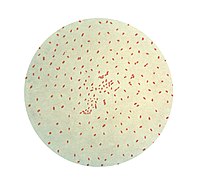
Photo from wikipedia
Manganese-dependent superoxide dismutase (MnSOD, SodA) and iron-dependent SOD (FeSOD, SodB) are critical cytosolic enzymes for alleviating superoxide stress. Distinct from the singular sodA gene in most bacteria, Stenotrophomonas maltophilia harbors… Click to show full abstract
Manganese-dependent superoxide dismutase (MnSOD, SodA) and iron-dependent SOD (FeSOD, SodB) are critical cytosolic enzymes for alleviating superoxide stress. Distinct from the singular sodA gene in most bacteria, Stenotrophomonas maltophilia harbors two sodA genes, sodA1 and sodA2. The roles of SodA1, SodA2, and SodB of S. maltophilia in alleviating superoxide stress were investigated. The expression of sod genes was determined by promoter–xylE transcriptional fusion assay and qRT–PCR. SodA2 and sodB expressions were proportional to the bacterial logarithmic growth, but unaffected by menadione (MD), iron, or manganese challenges. SodA1 was intrinsically unexpressed and inducibly expressed by MD. Complementary expression of sodA1 was observed when sodA2 was inactivated. The individual or combined sod deletion mutants were constructed using the gene replacement strategy. The functions of SODs were assessed by evaluating cell viabilities of different sod mutants in MD, low iron-stressed, and/or low manganese-stressed conditions. Inactivation of SodA1 or SodA2 alone did not affect bacterial viability; however, simultaneously inactivating sodA1 and sodA2 significantly compromised bacterial viability in both aerobic growth and stressed conditions. SodA1 can either rescue or support SodA2 when SodA2 is defective or insufficiently potent. The presence of two MnSODs gives S. maltophilia an advantage against superoxide stress.
Journal Title: International Journal of Molecular Sciences
Year Published: 2019
Link to full text (if available)
Share on Social Media: Sign Up to like & get
recommendations!